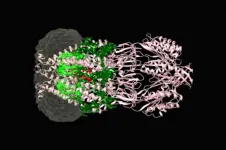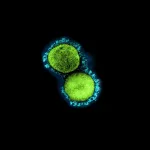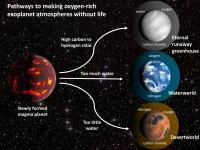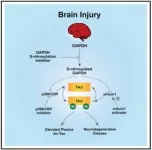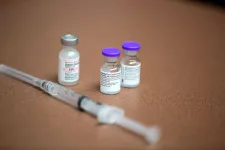INFORMATION:
This work was supported by National Institute of General Medical Sciences grant R01-GM120033, Cancer Prevention Research Institute of Texas grant RP170387, Houston Endowment, Chao Family Foundation and Huffington Foundation.
Novel guidelines help select optimal deconvolution method
2021-04-13
(Press-News.org) Biomedical scientists are increasingly using deconvolution methods, those used to computationally analyze the composition of complex mixtures of cells. One of their challenges is to select one method that is appropriate for their experimental conditions among nearly 50 available.
To help with method selection, researchers at Baylor College of Medicine and the Jan and Dan Duncan Neurological Research Institute at Texas Children's Hospital have extensively evaluated 11 deconvolution methods that are based on RNA-sequencing (RNA-seq) data analysis, determining each method's individual strengths and weaknesses in a variety of scenarios. From these analyses, the researchers derived guidelines that scientists can use to determine the deconvolution method that optimally fits their needs. The study appears in the journal Genome Biology.
"A great deal of work in biomedical research involves analyzing heterogeneous biological tissues to gain insight into the contribution of individual cells in, for instance, cancer growth or brain development," said corresponding author Dr. Zhandong Liu, associate professor of pediatrics-neurology at Baylor and director of the Bioinformatics Core of the Jan and Dan Duncan Neurological Research Institute.
Analyzing complex cellular mixtures is a difficult task. Researchers can conduct such analyses with laboratory techniques that physically separate and/or identify cellular components, but this method is time consuming and expensive.
Alternatively, researchers can use deconvolution methods that computationally extract information about individual cells in a mixture by analyzing large datasets derived from the bulk, such as RNA sequencing data.
For example, some researchers studying stem cells, a rare type of cell, might be interested in the percentage of these cells in the total blood cell population. They could conduct RNA-seq analysis of the bulk of cells and then apply a deconvolution method to determine the percentage of stem cells in the mixture. But, what method should they use?
In another example, if a scientist were interested only in the relative proportions of different cell types in a mixture, then one method would be best for deconvolution. But if the scientist wanted to find out the actual percentage of each cell type, then that deconvolution method would not be the best for that job, but another one that works better at providing that kind of answer. How can a scientist know which method works best in each situation?
"Our lab is one of many that developed deconvolution methods early on, contributing to the nearly 50 deconvolution methods currently out there to do this type of job," said first author Haijing Jin, a graduate student in Baylor's graduate program of quantitative and computational biosciences working in the Liu lab. "The methods are based on different mathematical models and/or different assumptions to try to solve deconvolution problems, which involve basically how to go from a bulk heterogeneous tissue to profiles of individual cells."
Because of this growing interest in deconvolution and the abundance of methods available, Liu and Jin felt that it was time to establish a guideline or benchmark to understand the strengths and the weaknesses of each method.
Running thousands of scenarios
The team studied 11 methods. They selected them according to the quality of the programing, the number of citations in the scientific literature and their popularity in the field.
"One of the challenges we faced was how to best test the strengths and weaknesses of each method in many possible scenarios," Jin said.
The researchers decided to use a computational or in silico approach that enabled them to simulate the thousands of scenarios necessary to test all the methods.
"All these scenarios represented real-life experimental situations in cell research, cancer research or developmental biology. We simulated each one of them so we could identify the best deconvolution method for each scenario for people who are interested in applying these methods to their experiments," Jin said.
"That's the value of this work," Liu said. "We are providing a benchmark study on various deconvolution methods and guidance for people working on different topics in biology to facilitate the analysis of their experimental results."
ELSE PRESS RELEASES FROM THIS DATE:
Inside the protein channel that keeps bacteria alive
2021-04-13
Almost all bacteria rely on the same emergency valves--protein channels that pop open under pressure, releasing a deluge of cell contents. It is a last-ditch effort, a failsafe that prevents bacteria from exploding and dying when stretched to the limit. If we understood how those protein channels worked, antibiotic drugs could be designed to open them on demand, draining a bacterium of its nutrients by exploiting a floodgate common to many species.
But these channels are tricky to operate in the lab. And how precisely they open and close, passing through a sub-conducting state and ending in a desensitized state under the influence of mechanical forces, remains poorly understood. Now, new research from ...
COVID-19 in our dust may help predict outbreaks, study finds
2021-04-13
A study done in rooms where COVID-19 patients were isolated shows that the virus's RNA - part of the genetic material inside a virus - can persist up to a month in dust.
The study did not evaluate whether dust can transmit the virus to humans. It could, however, offer another option for monitoring COVID-19 outbreaks in specific buildings, including nursing homes, offices or schools.
Karen Dannemiller, senior author of the study, has experience studying dust and its relationship to potential hazards like mold and microbes.
"When the pandemic started, we really wanted to find a way that we could help ...
NIH experts discuss post-acute COVID-19
2021-04-13
WHAT:
Many people who have COVID-19 make a full recovery and return to their baseline state of health; however, some people have symptoms or other sequelae weeks or months after initial SARS-CoV-2 infection. These heterogeneous symptoms were the subject of the virtual "Workshop on Post-acute Sequelae of COVID-19" hosted on Dec. 2 and 4, 2020, by the National Institute of Allergy and Infectious Diseases (NIAID), in collaboration with other institutes and centers of the National Institutes of Health. A paper published recently in Annals of Internal Medicine ...
Researchers reveal aging signatures across diverse tissue cells in mice
2021-04-13
Researchers have identified molecular signatures of the aging process in mice, publishing their results today in the open-access eLife journal.
Their analyses provide one of the most comprehensive characterisations of the molecular signatures of aging across diverse types of cells from different tissues in a mammal, and will aid future studies on aging and related topics.
Aging leads to the decline of major organs and is the main risk factor for many diseases, including cancer, cardiovascular and neurodegenerative diseases. While previous studies have highlighted different hallmarks of the aging process, the underlying molecular and cellular mechanisms ...
Study warns of 'oxygen false positives' in search for signs of life on other planets
2021-04-13
In the search for life on other planets, the presence of oxygen in a planet's atmosphere is one potential sign of biological activity that might be detected by future telescopes. A new study, however, describes several scenarios in which a lifeless rocky planet around a sun-like star could evolve to have oxygen in its atmosphere.
The new findings, published April 13 in AGU Advances, highlight the need for next-generation telescopes that are capable of characterizing planetary environments and searching for multiple lines of evidence for life in addition to detecting oxygen.
"This ...
What's in it for us: added value-based approach towards telehealth
2021-04-13
After interviewing various stakeholders from public and private healthcare systems (in Lithuania and the US), researchers Dr Agne Gadeikiene, Prof Asta Pundziene, Dr Aiste Dovaliene from Kaunas University of Technology (KTU), Lithuania designed a detailed structure revealing added value of remote healthcare services, i.e. telehealth. Adopting the concept of value co-creation common in business research to healthcare, the scientists claim that this is the first comprehensive analysis of this kind in the healthcare field involving two different healthcare systems.
According to the researchers, although in the US the consultations via phone with physician have been available for more than fifty ...
Gene therapy shows promise in treating rare eye disease in mice
2021-04-13
A gene therapy protects eye cells in mice with a rare disorder that causes vision loss, especially when used in combination with other gene therapies, shows a study published today in eLife.
The findings suggest that this therapy, whether used alone or in combination with other gene therapies that boost eye health, may offer a new approach to preserving vision in people with retinitis pigmentosa or other conditions that cause vision loss.
Retinitis pigmentosa is a slowly progressive disease, which begins with the loss of night vision due to ...
Researchers discover new way to monitor & prevent nerve cell deterioration after TBI
2021-04-13
Violent blows or jolts to the head can cause traumatic brain injury (TBI), and there are currently about five million people in the U.S. living with some form of chronic impairment after suffering a TBI. Even in a mild form, TBI can lead to lifelong nerve cell deterioration associated with a wide array of neuropsychiatric conditions. Tragically, there are no medicines to protect nerve cells after injury. Behind aging and genetics, TBI is the third leading cause of Alzheimer's disease (AD), yet the link between these two conditions is not understood.
In a new study, published online today in Cell, researchers have discovered a new way to prevent brain nerve cells from deteriorating after injury, which also revealed a potential mechanistic ...
Narratives can help science counter misinformation on vaccines
2021-04-13
AMES, Iowa - Narratives are a powerful tool that can help explain complex issues, but they can also serve as sources of misinformation, which presents a challenge as public health agencies work to educate people about COVID-19 vaccine.
In a paper published by the Proceedings of the National Academy of Sciences, author Michael Dahlstrom, a professor and director of Iowa State University's Greenlee School of Journalism and Mass Communication, examined how narratives or storytelling can help counter misinformation and provide a connection between science and the human experience. Dahlstrom says simply presenting the facts, without some connection, may not help people make ...
USPSTF statement on screening for vitamin D deficiency in adults
2021-04-13
Bottom Line: The U.S. Preventive Services Task Force (USPSTF) concludes that the current evidence is insufficient to make a recommendation about screening for vitamin D deficiency in asymptomatic adults. Vitamin D performs an important role in bone metabolism. Requirements may vary by individual and no one blood vitamin D level defines deficiency. The USPSTF routinely makes recommendations about the effectiveness of preventive care services and this recommendation updates and is consistent with its 2014 statement.
To access the embargoed study: Visit our For The Media website at this link https://media.jamanetwork.com/
(doi:10.1001/jama.2021.3069)
Editor's Note: Please see the article for additional ...
